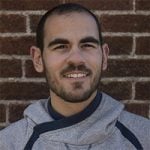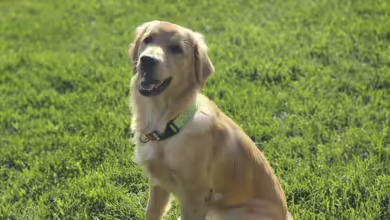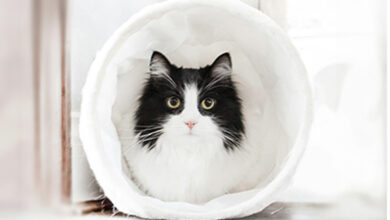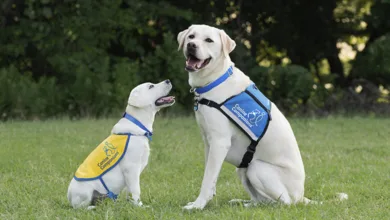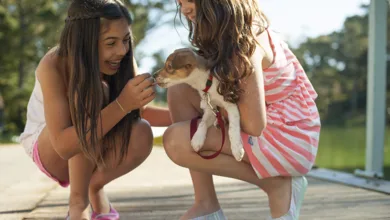
Above photo: Kathy holding a red-tailed hawk, one of the many patients brought in for care at the RWRC ~
Things break so easily, these days — from supply chains to communities to living beings. Television and social media flood us with news of broken systems down to the minute. If anything’s ever going to be fixed, it sure seems like someone had better get started on that soon.
That’s where Kathy Rogers comes in.
Kathy — Hawaiian-born, Dallas-raised — is 71 and almost 20 years into her retirement, but you wouldn’t know it. Though our conversation took place over the phone, her voice exuded a tirelessness that only comes from someone who mines energy from passion.
And energy is exactly what Kathy needs, because she’s the founder, owner, and chief caretaker of the Rogers Wildlife Rehabilitation Center, a 20-acre nonprofit in Hutchins, Tex., dedicated to rehabilitating and caring for orphaned, injured, and sick birds. In short, the RWRC aims to fix those too-easily broken things that fly, then to return them to the wild.
“Every time we take a bird in, not only are we helping that bird, but we’re helping the people that brought it in,” Kathy said. She could recall situations wherein she felt powerless and frantic, unsure of where to go and what to do for help. But with the RWRC, she and her team of volunteers can at least afford those who find “poor, injured things” — those birds so close to Kathy’s heart — a solution.
Kathy continued: “We’re helping people as well as helping birds. And that’s very important to me.”
Maybe you’ve heard of the RWRC before: The Center had some high-profile cases in the news throughout the past decade. There was the bald eagle in December 2013, seriously hurt and dangerously underweight. Kathy and her team brought him back from the brink and, a year after such care, released him back in to the wild.
There was the egret rookery rescue from 2014 to 2016. The bulldozing of rookeries in the middle of nesting season wreaked havoc on the baby egrets. Dozens had died and more were in danger of doing so. Again, Kathy and her team came to the rescue, caring for several hundred of the birds until they were old enough and strong enough to survive on their own.
More recently, in 2016, there was Beatrix, the rare Canadian peregrine falcon (and something of a Canadian celebrity) injured in a Dallas hailstorm. Kathy and her RWRC crew brought her back to health and back to her native Manitoba by the end of the year.
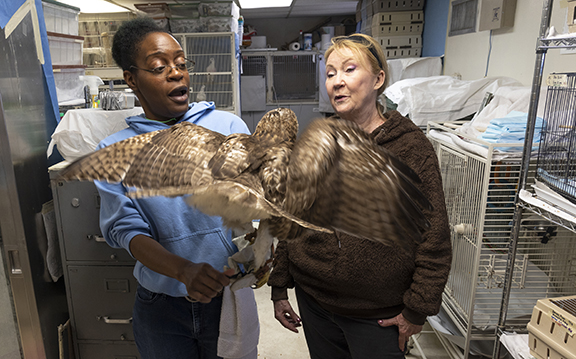
But people usually aren’t aware of these things, Kathy said. Of the bulldozed egret rookeries, she spoke of how the news reports caught people unaware; how the horror of the imagery on TV raised awareness of the birds’ plight more effectively than any kind of outreach program.
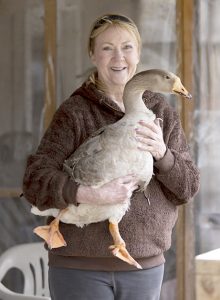
It’s clear to Kathy, her volunteers, and all those who support the Center’s work (the RWRC is funded entirely by private donations and some grants) they’re putting some good back into the world.
The RWRC’s impact has been felt around the world: Look no further than Honk the Goose, whose rescue story and relationship with filmmaker Cheryl Allison has spawned a picture book, a documentary, and almost 80 thousand followers on Instagram.
But Kathy’s no idealist. She knows people and their practices tend not to change.
There’s the apathy, of course, and there’s the convenience of old ways done easily. That’s apparent in the number of injured birds the RWRC admits for rehabilitation annually: The Center received 3,283 birds in 2015, and those numbers have only increased 10-15% each year, according to Kathy.
Most of this, due to human interaction with the environment: Poison kills rodents — and anything that eats them, like birds. Sticky traps ensnare bugs — and the birds that try to snack on them.
“You catch a cricket, it doesn’t really mean much. But when you see a cardinal or a wren stuck face-down,” Kathy said, “it means a little bit more.”
Kathy admitted she’s thought about closing shop in the face of this.
“Then I think all of those 6,000 birds that come through here would die if we weren’t here,” she said. “It’s just 6,000 out of hundreds of millions. And does it make a difference in the population? Probably not. Does it make a difference to those birds? Absolutely.”
There are cheap and easy ways to replace these old practices. Kathy suggested the use of boric acid for roaches and ants, but harmless to other critters that might dine upon them. Sevin Dust kills mites and fire ants without harming others. For rats and mice, fill a bucket of water with treats; the rodents will get stuck, but the birds scooping them up won’t.
Kathy didn’t start out so committed to avian rehabilitation, but “animals and critters are in my blood,” she said. She was young when her family moved from Hawaii to Dallas; once here, she was raised on a farm. Her father, a former prisoner of war in Japan during World War II, forbade her and her siblings from keeping animals in cages.
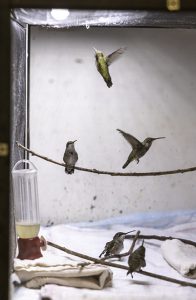
She didn’t fall for birds until her 20s, during a 1972 trip to Mexico. She found Charles, a double yellow-headed Amazon parrot, at one of the local markets.
He’d been snatched from a tree at night and crammed into a tiny cage, where he was filthy and underfed. She rescued him, acting on the impulse that would bring her to where she is now, almost 50 years later.
Kathy cared for Charles for 47 years. “Meanest parrot I’ve ever had in my life,” she said of him. But they found a way to get along.
Soon, the neighborhood kids were bringing her birds for her to rescue. At the time, Kathy knew little about avian rehabilitation. Such a practice didn’t really exist; books and veterinarians provided limited advice for domesticated birds, but wild birds are a different story. She learned through experience, slowly but surely becoming an expert at affording injured, sick, and orphaned birds the best quality of life possible.
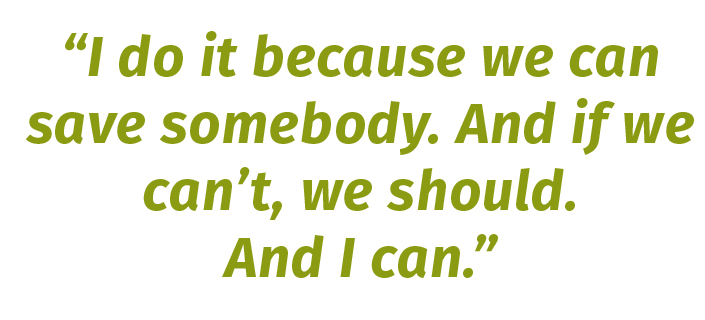
Kathy pointed to one of the RWRC’s success stories, Maggie the pelican, as an example. Maggie lost part of her wing after having it strangulated in a trot line. When she arrived at the RWRC, Kathy rehabilitated Maggie to the greatest extent, but Maggie’s ability to fly was forever lost.
Despite that, Maggie still lives like a queen. Each day, she cruises the grounds and enjoys five pounds of restaurant-quality fish: Argentinean sardines, Canadian ocean perch, Nordic herring. “She’s perfectly happy,” Kathy said. “She’s very at home here and doesn’t ever try to leave or even think about leaving or act like she wants to leave.”
Still, it took a long while for Kathy to get to this point. She filled a variety of jobs, from bridal consultant to department store buyer to managing farm livestock to working at the Dallas Zoo, all the while spending her spare time developing, building, and running the RWRC. She didn’t even retire until 2002, 13 years after the RWRC earned its nonprofit status and three years after it found its permanent home in Hutchins.
Her transition into retirement felt seamless, Kathy said, because retiring allowed her to commit full-time to the Rogers Wildlife Rehabilitation Center. She was able to dedicate herself fully and without reservation to the passion that had driven her for decades.
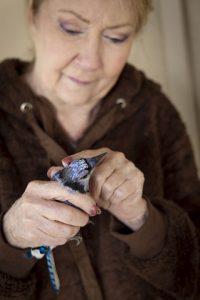
Now, she said she’s found herself even busier than before. Thanks to the value of the RWRC’s services and its stellar reputation with organizations such as the U.S. Fish and Wildlife Services, Kathy’s dream has become a 24/7 commitment. It doesn’t stop.
But that doesn’t matter to Kathy. Together with her staff at the RWRC, she’s found a way to use her expertise in such a way that affords truly visible benefit to wildlife and the environment — two of her great passions — while at the same time supporting a broad community of people.
“I was raised that you should leave this world a better place than it was when you came into it,” Kathy said. “This this is a very needed thing and, with the number of people to come in here, it’s a very fulfilling thing.”
She encouraged others, regardless of what stage of life in which they find themselves, to structure even a small part of their lives to feel like they’re making a difference.
Kathy has found a way to make her difference. She cares for those broken things, nursing them and encouraging them until they are whole — even if being whole is not the same as it was before.
“Anytime you find an injured critter, don’t just leave it,” she said. “See if you can get it in a box or a kennel and call a licensed person.”
It may a few phone calls, she continued, “but it’s always worth saving a life.” One important fix to help mend the world.
Found an injured bird? Call 972-225-4000 from 9 A.M. to 4 P.M., 214-236-1761 after hours, or email rogerswildlife@yahoo.com.
Visit www.rogerswildlife.org for more information or if you are interested in volunteering. The RWRC req uests all volunteers have their Covid-19 vaccinations and booster.
To learn more about Honk the Goose, follow @honk_thegoose on Instagram.

